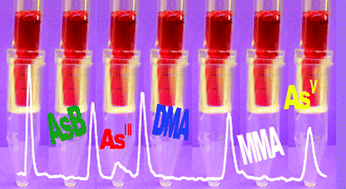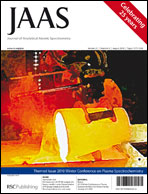A method was developed to quantify five arsenic species (As(III), As(V), monomethylarsonic acid (MMA), dimethylarsinic acid (DMA), and arsenobetaine (AsB)) in whole blood, using liquid chromatography (LC) coupled with inductively coupled plasma mass spectrometry (ICP-MS). The method can be used for routine monitoring of arsenic species in whole blood as well as in urine, but with different sample preparation. Whole blood was diluted 1 + 4 with reagents containing 3 mM HgCl2, which prevents As(III) from binding to the LC column. The diluted blood was subjected to ultrafiltration so as to remove molecules larger than 3,000 Daltons. Analysis was completed within 12 min, for the determination of arsenic species in whole blood, and within 11 min in urine; the method detection limit is < 0.3 μg L−1 for each arsenic species. The sum of arsenic species measured by the proposed method agreed well with assigned values for total arsenic in whole blood and urine reference materials, and in archived proficiency testing materials. Some urine reference materials provided additional information on the arsenic species present, and our testing results agreed well with the documented values.

You have access to this article
 Please wait while we load your content...
Something went wrong. Try again?
Please wait while we load your content...
Something went wrong. Try again?


 Please wait while we load your content...
Please wait while we load your content...